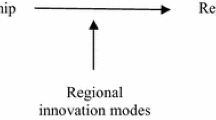Abstract
We give an overview of the contributions to this special issue and identify topics for further research. The contributions collected in this special issue document considerable advancements in the research about the effects of new business formation on regional development. Differences in these effects are found according to types of start-ups and their regional environment. Future research should try to shed more light on such differences. This particularly requires information about the characteristics of start-ups such as their knowledge intensity as well as their innovativeness and characteristics of their product program. Moreover, future research has to clarify to what extent new business formation is determined by previous or expected growth and to what extent start-ups have an effect on economic growth independent of an already existent development trend.
Similar content being viewed by others
References
Acs, Z., & Mueller, P. (2008). Employment effects of business dynamics: Mice, gazelles and elephants. Small Business Economics, 30(1), 85–100.
Andersson, M., & Noseleit, F. (this issue). Start-ups and employment growth—Evidence from Sweden. Small Business Economics.
Anyadike-Danes, M., Hart, M., & Lenihan, H. (this issue). New business formation in a rapidly growing economy: The Irish experience. Small Business Economics.
Audretsch, D., Boente, W., & Keilbach, M. (2008). Entrepreneurship capital and its impact on knowledge diffusion and economic performance. Journal of Business Venturing, 23, 687–698.
Bade, F.-J., & Nerlinger, E. A. (2000). The spatial distribution of new technology-based firms: Empirical results for West Germany. Papers in Regional Science, 79, 155–176.
Baptista, R., & Preto, M. T. (this issue). New firm formation and employment growth: Regional and business dynamics. Small Business Economics.
Bosma, N. (2009). The geography of entrepreneurial activity, Ph.D. dissertation, University of Utrecht.
Bosma, N., & Schutjens, V. (2009). Determinants of early-stage entrepreneurial activity in European regions—Distinguishing low and high ambition entrepreneurship. In D. Smallbone, H. Landstrom, & D. Jones-Evans (Eds.), Making the difference in local, regional and national economies: Frontiers in European entrepreneurship research (pp. 49–80). Cheltenham: E. Elgar.
Bosma, N., Stam, E., & Schutjens, V. (this issue). Creative destruction and regional productivity growth: Evidence from the Dutch manufacturing and services industries. Small Business Economics.
Brüderl, J., Preisendörfer, P., & Ziegler, R. (1992). Survival chances of newly founded business organizations. American Sociological Review, 57(2), 227–242.
Dejardin, M. (this issue). Linking net entry to regional economic growth. Small Business Economics.
Fritsch, M. (2008). How does new business formation affect regional development? Introduction to the special issue. Small Business Economics, 30, 1–14.
Fritsch, M., & Mueller, P. (2004). The effects of new business formation on regional development over time. Regional Studies, 38, 961–975.
Fritsch, M., & Mueller, P. (2008). The effect of new business formation on regional development over time: The case of Germany. Small Business Economics, 30, 15–29.
Fritsch, M., & Schroeter, A. (2009). Are more start-ups really better? Quantity and quality of new businesses and their effect on regional development. Jena Economic Research Papers # 070–2009. Jena: Friedrich Schiller University and Max Planck Institute of Economics Jena.
Fritsch, M., & Schroeter, A. (this issue). Why does the effect of new business formation differ across regions? Small Business Economics.
Harhoff, D. (1999). Firm formation and regional spillovers. Economics of Innovation and New Technology, 8, 27–55.
Koster, S. (this issue). Individual foundings and organisational foundings: Their effect on employment growth in the Netherlands. Small Business Economics.
Mueller, P., van Stel, A., & Storey, D. J. (2008). The effect of new firm formation on regional development over time: The case of Great Britain. Small Business Economics, 30, 59–71.
Schroeter, A. (2009). The effect of new business formation on employment—The dominance of density. Jena Economic Research Papers # 019–2009. Jena: Friedrich Schiller University and Max Planck Institute of Economics.
Schumpeter, J. A. (1942). Capitalism, socialism and democracy. New York: Harper and Row.
Tübke, A. (2004). Success factors of corporate spin-offs. Boston: Kluwer Academic Publishers.
van Stel, A., & Suddle, K. (2008). The impact of new firm formation on regional development in the Netherlands. Small Business Economics, 30, 31–47.
Author information
Authors and Affiliations
Corresponding author
Rights and permissions
About this article
Cite this article
Dejardin, M., Fritsch, M. Entrepreneurial dynamics and regional growth. Small Bus Econ 36, 377–382 (2011). https://doi.org/10.1007/s11187-009-9258-7
Accepted:
Published:
Issue Date:
DOI: https://doi.org/10.1007/s11187-009-9258-7




